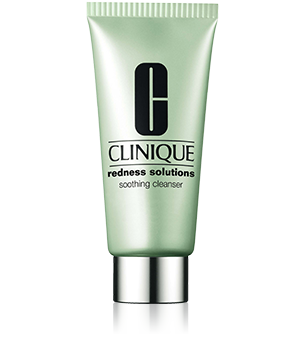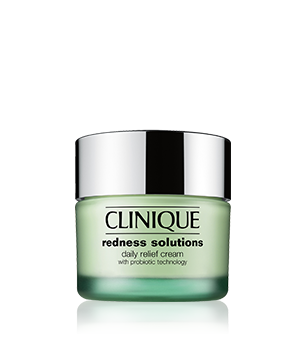this soothing system gives skin the daily care it needs.
Welcome to our 'redness free' zone.
Calms as it cleanses.
Instantly soothes visible redness.
Oil-free makeup primer protects with SPF.
Power Couple.
Help visibly calm skin for instant redness relief.
Redness Video
Clinique Presents: Facts on Redness
Redness Video
Ask the Doctor.
Dr. David Orentreich discusses the causes of redness and Rosacea—and what you can do about it.
Are there different types of redness?
Generally there are two types of redness: chronic persistent redness or Rosacea, and temporary, reactive redness. Frequent flushing that gets progressively worse with age is an early sign of chronic persistent redness. There also may be areas where little red bumps develop—eventually these go away, leaving an overall base of redness. Temporary redness is generally caused by sunburn or irritation from a skin care product. It’s often associated with itching and discomfort, and will usually disappear once the cause is removed.
What causes Rosacea or persistent redness?
Cause—and cure—are unknown. Flare-ups can be triggered by many factors, different for each person: spicy food, alcohol, physical activity, heat/cold, sunlight, stress, harsh cleansing, medications. According to the American Academy of Dermatology, Rosacea affects as many as 14 million Americans, more women than men, especially fair-skinned adults age 30-50 who flush or blush easily. Typically, it develops slowly, lasts for years and becomes worse with age.
How do you know when redness is Rosacea?
By the location. It's usually located in a bowtie or butterfly pattern across the nose and on the cheeks, and you’ll see little blood vessels if you look closely look at the skin. Most people with Rosacea report periods where they flare-up and develop small inflammatory acne-like bumps—but teenage acne shouldn’t be confused with Rosacea.
Is Rosacea a form of acne?
No. Although flare-ups are often accompanied by tiny red “pimples,” unlike acne there are no blackheads or whiteheads. Rosacea-prone skins can be dry and flaky instead of oily, with “pimples” that don’t respond to acne treatments. (Acne-prone skins will find Clinique’s Acne Solutions to be highly effective at clearing blemishes.)
When is redness considered reactive?
With reactive redness, most patients report that there was a preceding event that triggered it. It could be something they were sensitive to and applied to the skin. It could be a sunburn or a medicine they took, and after they discontinued these irritants, the skin returned to normal. Reactive redness tends to be itchier and more uncomfortable than persistent redness.
What’s the best way to treat redness?
If redness is due to a temporary cause and the skin is irritated, use topical preparations with anti-irritants to soothe it. Generally with time this condition will disappear and the skin will return to its normal state. Persistent redness is a chronic condition that can flare up at any time. During an active flare-up, use topical treatments to calm the skin, along with specially formulated products with a green or yellow tint that help conceal redness.
Is redness a sign of aging?
Yes. If Rosacea runs in your family, there’s a good chance you’ll have it, too. But years of sun, dehydration and skin’s natural thinning as we age can also make bouts of redness very common. Best strategy: treat redness early on because persistent flare-ups and chronic irritation make things worse.







